
4th Grade Website

 |
Lucinda Surber’s 4th Grade Website |
 |
![]()
![]()
You can find our room using the signs in words and numbers and in Braille!
Pairs of students in our class created portraits of Geometoids (creatures composed of geometric shapes) and then wrote descriptions of the Geometoids. Students in our partner class at Escondido tried to re-create our Geometoids after reading our descriptions while we did the same for theirs. Then we compared the original Geometoids portraits with the recreations and evaluated our descriptions. Visit our Geometoids webpages to see the results.
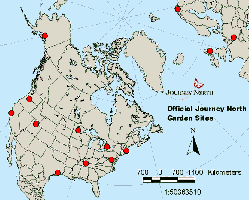 We
will join classrooms all across the Northern Hemisphere in a telecommunication
project to track the progress of spring by observing the emergence of tulips.
Our class will serve as one of the 13
Official Journey North Tulip Gardens.
Our first activity was predicting what
order the 13 Official Tulip Gardens would bloom. Students used three main strategies
for deciding which locations would experience spring first: spring would come
later to latitudes closer to the North Pole, for locations at the same latitude
those nearer an ocean would bloom first, and personal experience with climate
in locations close to the official gardens.
We made sketches
of our bulbs (more sketches)
and learned about the parts of the bulb.
We dug
six inch holes, planted, and watered
our bulbs on December 6th. The weather was sunny and the temperature was 60° F.
(Here is our
data form at the Journey North website.) Since the
squirrels think our tulips bulbs make tasty snacks, we protect our planter
box with the squirrel
guard behind our planter.
A
description of our Tulip Project is featured in Intel’s
An Innovation Oddessy. I also wrote the unit plan for Intel’s
Innovation in Education: The
Wave of Spring.
We
will join classrooms all across the Northern Hemisphere in a telecommunication
project to track the progress of spring by observing the emergence of tulips.
Our class will serve as one of the 13
Official Journey North Tulip Gardens.
Our first activity was predicting what
order the 13 Official Tulip Gardens would bloom. Students used three main strategies
for deciding which locations would experience spring first: spring would come
later to latitudes closer to the North Pole, for locations at the same latitude
those nearer an ocean would bloom first, and personal experience with climate
in locations close to the official gardens.
We made sketches
of our bulbs (more sketches)
and learned about the parts of the bulb.
We dug
six inch holes, planted, and watered
our bulbs on December 6th. The weather was sunny and the temperature was 60° F.
(Here is our
data form at the Journey North website.) Since the
squirrels think our tulips bulbs make tasty snacks, we protect our planter
box with the squirrel
guard behind our planter.
A
description of our Tulip Project is featured in Intel’s
An Innovation Oddessy. I also wrote the unit plan for Intel’s
Innovation in Education: The
Wave of Spring.
We will collect monthly data about Matadero Creek this year. Our first Creek Observation was on Thursday, September 7th. You can see our data on our Matadero Creek Data page.
Passport to California and Suitcase Presentations: We enjoyed hearing the stories of how our families came to California during the Suitcase Presentations. Data about the arrival of our families in California can be found in the 2006–2007 Class Statistics.
California Geography: We learned about latitude and longitude and how to read all types of maps of California. Our final project was to make a relief map of the our state. We sketched the major geographical features of the state of California on large boards and modeled the mountains and valleys with a goopy mixture of salt and flour. After the “goop” dried, we painted the elevations and the surrounding states. Finally we located five important cities and made a key. We agreed that this was a fun and messy project! The finished maps are quite impressive. Here are two examples.
Investigating Artifacts: In the first section of this unit we walked to Bol Park to collect natural materials which we sorted and classified. We used our natural materials for a math lesson on Venn Diagrams. It was fun trying to figure out the Secret Sorting Rule of each Venn Diagram: Venn Diagram #1, Venn Diagram #2, Venn Diagram #3. Most were very hard to guess! Then we made masks. In the second section we listened to myths, wrote our own myths, created posters (more posters) to illustrate the myths, and shared our myths around a “campfire” in our classroom. In the final section of the unit we excavated “middens” by carefully sieving the soil, cleaning and polishing the artifacts, and recording the spot where each artifact was discovered with a sketch and a label. The completed midden maps (midden map #2, midden map #3, midden map #4) and museums (museum #2, museum #3, museum #4) helped us draw inferences about the culture from the artifacts we found.
California Explorers:
Each group chose an explorer who was important in the history of California.
Students made timelines of California and placed their explorers in time, made
maps to show where the explorers traveled, drew portraits of what the explorers
might have looked like, and wrote essays about the goals and accomplishments
of the explorers. Then each group created a poster and made a presentation
to the rest of the class. Explorers we learned about:
• Álvar Nuñez Cabeza de Vaca
• Hernán Cortés
• Sir Francis Drake
• Gaspar de Portolá
• Sebastián Vizcaíno
Mission Period: Each student chose one of the 21 California Missions as the topic of a research report. We learned how the Spanish changed the lives of the Native Californians and wrote letters from the perspective of a Native American who had joined a mission. Our final project was creating a HyperStudio stack to publish our reports.
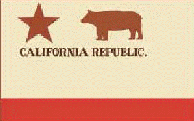 Americans
Arrive: For this period of California history, we
shifted perspective and looked at California from the American point of view.
We learned about the fur traders that opened new routes to California, and the reaction to
the news of the new land to the west they took back to the United States.
We tried to understand the hard decisions pioneers from the United States
traveling to California in wagon trains had to make along the way. Then we
studied the Bear Flag Revolt of 1846, which proclaimed California an independent
republic. The California Republic lasted for less than three weeks, but did
influence our state flag!
In his memoirs, the Recuerdos (Recollections), General Vallejo wrote, “the
bear looked more like a pig than a bear.”
Americans
Arrive: For this period of California history, we
shifted perspective and looked at California from the American point of view.
We learned about the fur traders that opened new routes to California, and the reaction to
the news of the new land to the west they took back to the United States.
We tried to understand the hard decisions pioneers from the United States
traveling to California in wagon trains had to make along the way. Then we
studied the Bear Flag Revolt of 1846, which proclaimed California an independent
republic. The California Republic lasted for less than three weeks, but did
influence our state flag!
In his memoirs, the Recuerdos (Recollections), General Vallejo wrote, “the
bear looked more like a pig than a bear.”
All About Us: Our first math unit was an introductory data collection and graphing unit. We started by collecting some information about our class. We learned all sorts of interesting things about our class and organized our data with bar graphs and Venn diagrams. Here are some examples of the charts and graphs we used to collect and display our data. This Venn diagram shows our lateral dominance. This bar graph illustrates our favorite sports, and this one shows our heights. This circle graph (pie chart) shows the languages we speak at home.
Mathematical Thinking in 4th Grade: In our second math unit we worked on mental math skills by playing games like Close to 100 and 101-200 Bingo. We used patterns to solve related problem sets mentally. We finished this unit by creating symmetrical designs. We began by reviewing Mirror Symmetry. We created some designs that had both Mirror and Rotational Symmetry. The hardest was creating designs that had Rotational Symmetry but NOT Mirror Symmetry.
Arrays and Shares: In our third math unit we practiced our multiplication facts through 12 x 12 and worked on multiplication and division problems.
Landmarks in the Thousands: In our fourth math unit we investigated our number system by working with problems in the 100s and 1000s. The final activity for this unit was making a 10,000 chart, which was huge!
Equal Shares, Different Pieces: We explored fractions in this unit. While looking at fractions as equal area divisions, we made Quilts of Fourths (more examples, more examples). We also used the area model to divide Squares and Rectangles into fractional parts.
Money, Miles, and Large Numbers: We worked with decimal numbers in this unit, spending money to buy lunch in different restaurants, spending $100 to buy books for a 1st grade classroom, figuring total miles run each week, and adding and subtracting both very small and very large decimal numbers.
Area and Perimeter: In this unit we began by figuring the area and perimeter of our feet. Then we investigated the different perimeters possible for one area and the different areas possible for one perimeter by designing banquet tables and gardens.
The Shape of the Data: In this unit we collected and organized data and learned about statistics. We collected data about our families, compared the heights of 1st and 4th graders, and investigated sleep patterns. The range of our school night sleep was 7 to 11 hours and 6 to 12 hours on weekends. Packages and Groups: In this unit we practiced multiplication and division with two and three digit numbers.
Sunken Ships and Grid Patterns: We learned how to do coordinate graphing in all four quadrants and how to program the computer using LOGO commands to make geometric shapes and patterns.
Reading Log: Students must read at least 30 minutes a day for 4 days each week. Parents must initial the Reading Log each day. The Reading Log is due every Wednesday.
Appearances: Our first book has two stories linked by the theme of not judging by appearances: “Brother to the Wind” and “The Cat Who Thought She Was a Dog and the Dog Who Thought He Was a Cat.”
Island of the Blue Dolphins, by Scott O’Dell, helped us understand the life of the Chumash. We illustrated our favorite parts of the book captioned with a quote from the novel. We wrote poems using similes (a favorite literary device of Scott O’Dell), created crayon and water color art projects featuring organisms from the book, and learned to use a quote from the book to illustrate a favorite part (illustration, illustration, illustration, illustration). For our final activity we watched the movie adaptation of the book and discussed the similarities and differences.
Babe, the Gallant Pig, by Dick King-Smith, was fun to read even though the dialect was often difficult to understand. We learned many new vocabulary words about sheep herding and discovered how being brave and polite can lead to success. The final activity for this book was to create ribbons (three examples and three more) summarizing how each character helped Babe achieve his goal.
Literature Circles: In Literature Circles we practice and refine
the skills needed to participate in book discussions: choosing discussion
questions, leading a discussion, making connections between literature
and real life, learning new vocabulary words, identifying and appreciating
literary elements. These are the books groups have read so far:
• Bridge to Terabithia, by Katherine Paterson
• Bunnicula, by Deborah and James Howe
• A Long Way from Chicago, by Richard Peck
• Amber Brown is Green with
Envy by Paula Danziger
• Because of Winn Dixie by Kate DiCamillo
In the Year of the Boar and Jackie Robinson, by Bette Bao Lord, helped us to understand what is was like to immigrate to the United States from China in 1947.
By the Great Horn Spoon! by Sid Fleishman, was a funny historical fiction about a boy and his butler who traveled to the gold fields in California from Boston around Cape Horn.
Creatures: Our first writing assignment was to describe the imaginary creatures created by three students working secretly to make the different sections. Here are two examples of our creatures, two more, and two more.
 Opinion About Me: After reading An Anteater Named
Arthur, by Bernard
Waber, we wrote essays describing an opinion our family has about us.
Like Arthur’s mother, we tried to use specific details and strong adjectives
to support our topics.
Opinion About Me: After reading An Anteater Named
Arthur, by Bernard
Waber, we wrote essays describing an opinion our family has about us.
Like Arthur’s mother, we tried to use specific details and strong adjectives
to support our topics.
Folding Books: We began our work with personal narratives by writing two short books about an event we felt strongly about. We worked on strong first sentences that “grab” the reader’s attention, and sticking to the topic. (two covers, two more covers)
Persuasive Essays: We wrote two essays trying to convince our audience to accept our topic statement. We worked on writing strong supporting points to prove our topic and using a variety of sentences.
Object Perspective Essays: For this essay we practiced writing from another point of view by imagining we were an inanimate object we see every day, like a stuffed aminal or a pillow.
Spices: We began by learning about the Spice Trade, when explorers search for quicker routes to the spice lands. Each child chose two spices to investigate. We practiced using separate note cards to organize topics, skimming for important information, and taking notes in phrases rather than copying whole sentences from the source.
Mission Reports: Each student selected one of the 21 California missions as the subject of a research report. We practiced many report-writing skills: skimming for specific information, note taking, organizing information, presenting factual information accurately and in an interesting way, writing a bibliography. After taking notes we wrote rough and final drafts for each section. For the final draft we used a program called HyperStudio. Students learned how access the tool pallets and drawing tools to create a floor plan of the mission. When the text on a page was finished, students learned to use the painting tools to decorate the page.
Water: We observed several properties of water: surface tension, rate of flow, and expansion/contraction with changes in temperature. We observed that hot water (tinted red) floats in a glass of room temperature water while ice cold water (tinted blue) is so dense that it remains in the small vial at the bottom of the cup. (picture of experiment) We also investigated how location and surface area influence the rate of evaporation and explored condensation. Using a chemical indicator, we tested to see if water samples were hard or soft. We investigated what happens when water flows over different Earth materials, tested water from home, and conducted a blind Taste Test of five different waters. Our final activity was to build water wheels to experiment with the way water flows. Here are some of our water wheel designs.
Magnetism & Electricity: In this unit we began by studying magnetism and experimenting with the forces of attraction and repulsion. We were amazed by how many spacers it took to break the force of attraction. We then began to experiment with electricity. We tested objects to see if they were good conductors and insulators and built a simple circuit with by a switch that controlled a motor. We discovered how to light a bulb (using just one battery, one bulb, and one wire) and explored open and closed circuits. We are getting better at tracing the flow of electricity in our heads to predict if a diagram will result in a complete circuit that will light the bulb. We learned to make schematic diagrams, using symbols to stand for the different parts of our circuits. We experimented with series and parallel circuits. With one D-cell battery we were able to light only four small bulbs wired in series. With the same D-cell battery we were able to light 12 bulbs wired in parallel. We built an electromagnet and experimented with the effect the number of times we wound the wire around the core would have on the strength of the electromagnet. Then we used our electromagnets to build a telegraph and practiced sending messages in code. As a final activity for this unit, students designed an investigation to answer a question about magnetism or electricity or are worked on a project to demonstrate something they learned. As we investigated questions, we learned how to set up experiments, how to test equipment, and how to problem-solve circuits that didn’t work the way we expected them to!
Animal Studies: In this life science unit we observed and cared for Dwarf African Frogs, Fiddler Crabs, and Land Snails. We learned many interesting things by watching our animals and taking accurate observational notes. The final activity was for each group to choose a question that could be answered by observation. Each group then presented the results of their observations to the rest of the class. The investigation questions were:
 |
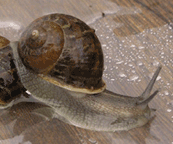 |
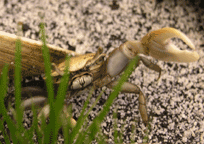 |
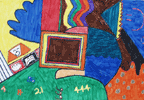 |
Quilts: Each student made a Crazy Quilt with a different design in each quilt piece.The finished individual quilts are displayed together in a class quilt which symbolizes all of the different personalities that are joined together into one whole classroom community. Here are four example quilts, four more, four more, four more, four more, and the last one. |
|
|---|---|---|
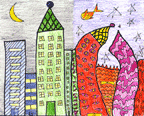 |
Buildings: In this SPECTRA lesson we reviewed line and color. Then we created two cities. Our left buildings were created with straight lines and colors to give a feeling of order and calm; our right buildings were created with curved lines and colors to give a feeling of action and chaos. Here are two examples, two more, and a final two. Ms. Surber has a great time when Erna teaches SPECTRA lessons since she gets to make one too! | |
 |
Where’s Ms. Surber? In this SPECTRA lesson we learned about the proportions of the human body. Then we created self portraits which we assembled into a class Where’s Waldo type collage. Our class self portraits will be added to the entire Barron Park collage. Here are four of us, another four, six of us, five more, a final four, and the whole class. | |
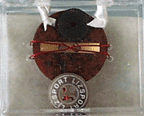 |
Amulets: In preparation for a field trip to the Palo Alto Art Center we talked about transitions and how some objects help you feel protected or safer during a time of change. After touring the art exhibit THE TRANSITIONAL OBJECT, we created amulets to symbolize a special feeling or power. Here are six examples and six more. | |
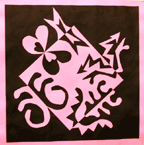 |
Japanese Notan Design: Positive and Negative Space In this SPECTRA lesson we discussed the Japanese concept of Notan, the interaction between positive (light) and negative (dark) space. We looked at designs that included positive and negative shapes and then created our own designs. Here are four examples, four more, and a final four. |
|
 |
Island of the Blue Dolphins: After reading Island of the Blue Dolphins, by Scott O’Dell, we created crayon and watercolor pieces depicting symbols from the book. We divided our paper into sections with crayon, and used a template to make our larger designs. Here are four examples, four more, four more, and a final four. | |
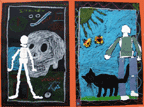 |
Day of the Dead: In this SPECTRA lesson we learned about the Day of the Dead and then used pastels to draw designs on black paper to honor a member of our family. Then we glued our torn paper bodies on top of the background. The last step was to add details with fabric, sequins, etc. Here are two examples, two more, four more, two more, two more, and a final two. | |
 |
Masks: We collected natural materials and made masks on tagboard faces. Each mask had its own personality! Here are four, six more, six more, and a whole bunch. | |
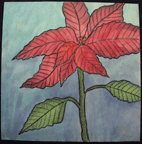 |
Poinsettia Still Life: In this SPECTRA lesson we sketched poinsettia plants with black markers. We tried to make at least part of our drawing go off of the page. Then we used watercolors to paint the sketches as realistically as we could. Here are four examples, four more, and a final four. | |
 |
Explorer Portraits: We made portraits using pen and watercolor while studying explorers important to the history of California. For some of the explorers we had to use our imaginations since no one knows what they really looked like. Here are portraits of Álvar Nuñez Cabeza de Vaca, Hernán Cortés, Sir Francis Drake, Gaspar de Portolá, and Sir Francis Drake & Sebastián Vizcaíno. | |
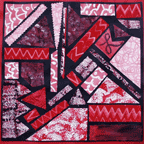 |
Exploration of One Color: In this SPECTRA lesson we started by making textured designs using one color of poster paint. The next week we talked about balance and then created a square collage by cutting our textured design and arranged the pieces into a balanced composition. Here are four examples and four more. | |
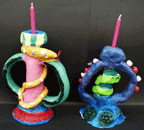 |
Mexican Tree of Life: In this SPECTRA lesson we learned about Mexican tree of life folk art. We reviewed how to work with clay, adding one piece of clay to another. We discussed the process of taking clay from its moist form to a fired piece. We created our own Tree of Life, adding texture and small objects like birds and flowers. After our pieces were fired, we painted them with acrylic paints and added sequins, flowers, and candles. Here are two examples, two more, and a final two. | |
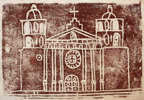 |
Mission Prints: We sketched our missions, used carbon paper to reverse our sketches, traced the carbon paper onto foam board, and then printed with brayers and block printing ink. This was a long and messy project, but the prints were amazing! Here are four examples, four more, and a final four. | |
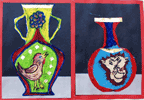 |
Chinese Cloisonné Vases: In this SPECTRA lesson we learned about Chinese coloisonné. We designed a vessel shape and decorated the vessel with oil pastels. Our final step was to add a touch of gold. Here are six examples and six more. | |
 |
Tissue City: In this SPECTRA lesson we first prepared a tissue collage background using starch and tissue paper. The following lesson we looked art art prints of city scenes and created our own cities using small pieces of cardboard to stamp black tempura lines. The objective of the lesson was to form an abstract design suggesting a city by stamping the cardboard in various ways to make lines and curves. Here are four examples and four more. | |
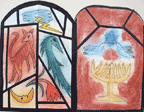 |
Marc Chagall Windows: For two weeks our class studied the art of Marc Chagall though the “Meet the Masters” program. One Friday the Meet the Masters teacher, showed us many prints of Marc Chagall’s beautiful paintings and stained glass windows. The prints stayed in our class for a week so that we could look at them closely. The next Friday we created a “stained glass” window using chalk and cut paper. We enjoyed choosing symbols from our own lives and then altering them as Chagall did. Here are two examples, two more, and a final two. | |
 |
Self Portraits: Realism to Abstraction: In this SPECTRA lesson we learned about correct placement of features and the shape of the feathers. We concentrated on drawing realistic eyes. Using mirrors we drew a pencil self portrait and then went over our portrait with black ink. The next session we used copies of our realistic portrait to compose an abstrat portrait with collage or by weaving papers together. Here are four examples, another four, four more, and a final four. | |
 |
River Maps: In this SPECTRA lesson we learned about different kinds of lines and looked at Wayne Thiebaud’s aerial landscapes. We drew a river with pastels and then added black pastel roads using both organic and geometric lines. We added patterns to each section with pastels and then used water colors. Here are two examples, two more, another two, and a final four. |
| Mission San Juan Bautista |
 |
|---|---|
| Peralta Adobe |
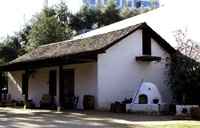 |
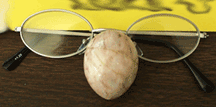
Stuffed Animal Day: Lots of stuffed animals came to Room 17 for the day.
Rock Day: Some interesting rocks appeared in Room 17.
| Lucinda Surber Site Launched: July 9, 1996 Updated: November 28, 2010 |